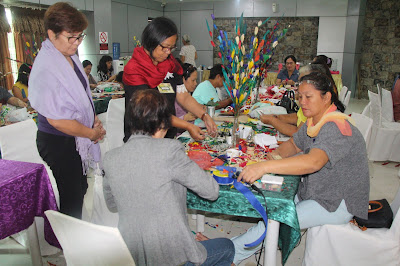From trash
to cash.
The most
joyful day of a farmer is upon seeing the crop on maturity stage. After three
months of careful management, Alona Daal, a corn farmer of E.G. Montilla, Las
Nieves, Agusan del Norte is so excited to harvest her corn field. After removing the bushel, she just leave the
corn husk and other wastes in the farm to let it decompose to incorporate back
the nutrients to the soil.
However, she
confided that some of her co-farmers resorted to burn farm wastes. But setting
farm wates into fire poses an environmental hazard and a violation of the Solid
Waste Management Act (RA 9003) and Philippine Clean Air Act of 1999 which prohibit
open-field burning, including burning of farm wastes.
One of the
farm waste or trash in the corn field is the corn husk, the outer protective
covering of an ear of corn. In rough estimate, Caraga Region accumulated around
23.1 ton of corn husk per harvest season.
But do you
know that instead of treating corn husk as a trash, there are people that considered
it as a gold.
Corn husk
can be transformed into very attractive decorative products such as flowers,
dolls, gift items perfect for any occasion such as a wedding, graduation,
special ceremonies and occassons or just plainly for house and office
decorations.
Seeing the
potential of the products and to empower women to help augment family's income,
DA Caraga through the Corn Program conducted recently a Corn Processing
Utilization Training in Butuan City.
The
participants who were mostly farmer’s wives were taught on creating gift or decorative
products utilizing corn husks through the resource person Ms. Lucila Esdrelon, a
retired employee of the Provincial Agriculture Office of the Province of Agusan
del Norte.
Notably, few
men also took part in the training with equal eagerness to learn the craft.
Lucila
Esdrelon appealed to the farmers, not to treat corn husk as farm wastes but an
opportunity to earn more.
“Lot of
decorative products can be made out of corn husk where wives can maximize their
time and help contribute to family’s income,” she said.
Editha
Dedomo, Rural Improvement Club (RIC) Federation President of Esperanza, Agusan
del Sur said that she is so happy that she was chosen as one of the participants
on the said training as it enhanced her knowledge more on the handicraft
making.
“I’ve been
doing this craft for quite sometime. During graduation time, lei out of corn husk is a sought after products,
so I can make money of out it, or gift items during a wedding, so it is really
a big help for my family,”
Meanwhile,
Annabelle Coral, Vice President of the City of Cabadbaran Abaca Handicraft
Makers Association Incorporated shared that corn husk handicraft making needs
patience and perseverance since you need to give attention up to its minutest
detail of the design to come up with an attractive and elegant product,’ she
said.
After the
training, various decorative and gift item products had been made that surely
capture the eye of the would be costumers. A decor product from corn husk could
be sold from P75 and as high as P500.00 depending on its size and intricacy.
Indeed, there
is money in trash (may pera sa basura). (Aurelius P. Arais/DA Caraga)
=-###-=






